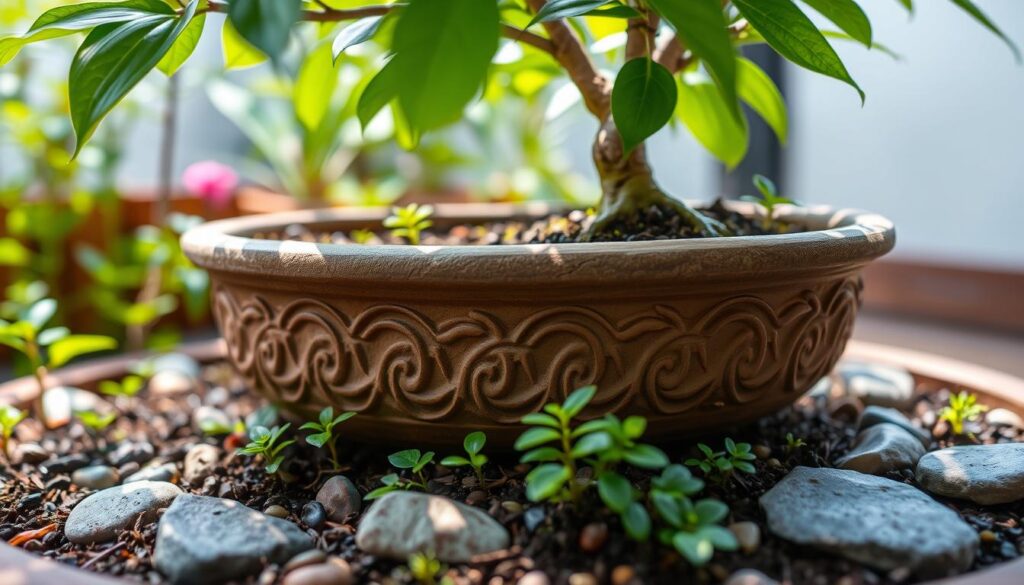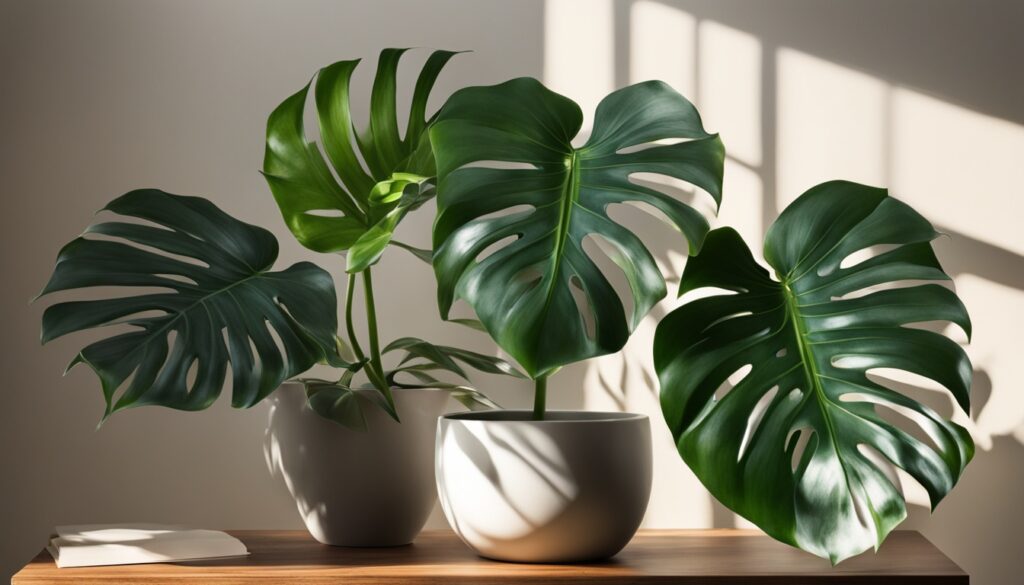Ever wondered what makes a bonsai tree pot special? Creating a miniature garden with your bonsai is an art. The right pot can highlight your bonsai’s beauty and keep it healthy. What should you look for in the perfect bonsai tree pot?
Bonsai tree pots are key to your miniature garden. They come in many styles, from traditional to modern. The right bonsai pot can make your bonsai look great and meet its needs. Look for good drainage, wiring holes, and the right size and shape.
Key Takeaways
- Bonsai pots are crucial for your miniature garden’s look and health
- Ceramic and porcelain are the top choices for bonsai pots
- Good drainage, wiring holes, and the right size are key in a bonsai pot
- Bonsai pots vary in price, from affordable to expensive
- The right bonsai pot can improve your miniature tree’s harmony
Understanding the Art of Bonsai Container Gardening
Bonsai is the ancient art of growing tiny trees. It has a long history. The tree and its container are key parts of this art. Containers are often shallow and stylish, guiding the tree’s growth and highlighting its beauty.
History of Bonsai Containers
Bonsai container gardening started in China, known as “penzai.” It was later perfected in Japan. There, people started collecting and potting small trees as early as the 13th century. These containers are essential, showing the tree’s delicate balance with its environment.
Essential Components of Bonsai Cultivation
- The bonsai tree, carefully selected and trained to mimic the appearance of a mature, full-sized tree
- The bonsai container, typically shallow and well-suited to the tree’s size and style
- The specialized bonsai soil, designed to provide optimal drainage and nutrient delivery
The Relationship Between Tree and Container
The bonsai container is vital for the tree’s health and look. Shallow pots help control the tree’s size. They also ensure the roots get enough room to grow. Good drainage is key, with pots often having many holes to avoid root rot.
Choosing the right container is crucial. It makes the bonsai look complete and beautiful. By knowing the history and importance of the tree and container, bonsai lovers can grow stunning plants. These plants add beauty and peace to any bonsai gardening supplies or bonsai pottery collection.
“The art of bonsai is not just about growing a small tree, but rather creating a living, breathing work of art that captures the essence of nature in miniature.”
Choosing the Right Pot for Bonsai Tree
Finding the right pot for a bonsai tree is key for its health and looks. When picking a bonsai planter, think about the tree’s size, style, and gender. The pot should match the bonsai well, creating a nice balance.
Experts say the pot’s height should match the trunk’s width above the roots. Oval and rectangular pots are 2/3 the tree’s height. Round or square pots are about 1/3 the height.
Trident maples need deeper pots because their roots grow fast. The pot’s design, whether masculine or feminine, also matters. It helps match the bonsai’s look.
| Pot Shape | Typical Height Ratio | Characteristics |
|---|---|---|
| Oval | 2/3 of tree height | Suitable for reflecting the femininity of deciduous trees, clump style bonsai, groves, and forests |
| Rectangular | 2/3 of tree height | Recommended for coniferous species and big deciduous trees with very pronounced taper, wide base, and heavy buttressed nebari to add a feeling of strength in the tree |
| Round | 1/3 of tree height | Ideal for coniferous or deciduous feminine trees, particularly for literati/bunjin trees |
The choice of pot design, whether masculine or feminine, plays a significant role in harmonizing the overall composition of the Bonsai tree.
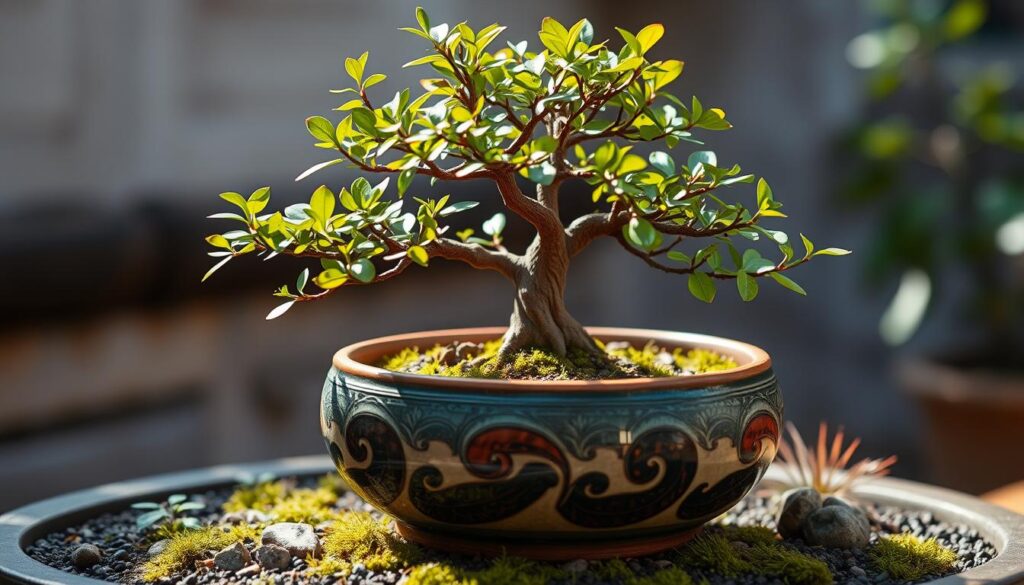
The color of the bonsai planter is also important. Choose earth tones like brown, gray, for warmth. Bright colors can highlight the tree’s leaves and bark.
The best pot for a bonsai tree makes the plant look great and thrive. It should create a beautiful display.
Material Matters: Types of Bonsai Containers
Choosing the right container is key for growing bonsai trees. It affects their health and looks. From traditional ceramic and porcelain to new materials, each has its own benefits and things to think about.
Ceramic and Porcelain Options
Ceramic and porcelain are top picks for bonsai pots. They don’t absorb water and drain well. This makes them great for keeping trees healthy. They come in many styles, colors, and finishes, so you can find the perfect match for your tree.
Alternative Materials for Bonsai Pots
While ceramic and porcelain are favorites, you can also try concrete, plastics, and metals. These offer durability and design flexibility. But, make sure they don’t harm your bonsai with toxins.
Drainage and Wiring Requirements
All bonsai pots need holes for drainage and wiring. This keeps the roots healthy and lets you shape the tree. It’s important for the tree’s growth and look.
| Pot Material | Key Benefits | Considerations |
|---|---|---|
| Ceramic | – Breathable material for healthy roots – Variety of styles and finishes – Durable and long-lasting |
– Can be fragile and prone to cracking |
| Porcelain | – Impermeable to water absorption – Highly durable and scratch-resistant – Wide range of decorative options |
– May be more expensive than ceramic |
| Concrete | – Extremely durable and long-lasting – Customizable shapes and sizes |
– May be heavy and difficult to move |
| Plastic | – Inexpensive and versatile – Ideal for young trees and initial growth |
– Less aesthetically appealing than other options |
Choosing between bonsai ceramics and bonsai pottery is important. It affects your bonsai’s health and growth. Knowing the pros and cons of each material helps bonsai lovers make the best choice for their trees.
Size and Proportion Guidelines for Bonsai Planters
When choosing bonsai planters, size and shape matter a lot. The pot’s height should match the trunk’s width above the roots. For oval and rectangular pots, aim for 2/3 of the tree’s height. Round or square pots should be 1/3 of the height.
For trees with big leaves, use wider pots. This makes the pot shorter, keeping the tree and pot in balance. This balance makes the bonsai look good and stay healthy.
- The pot length should be a bit larger than 2/3 of the tree’s height.
- The pot width should be slightly smaller than the total width of the branches.
- When selecting a pot for a double, twin, multiple trunk, raft, or group style, the proportion between the tallest tree and the pot length should be considered, with the pot length being 1/3 smaller than the height of the tallest tree.
- In multiple trunk styles, the length of the pot should be 2/3 of the height of the tallest tree.
“The size and proportion of the bonsai planter are crucial for the overall aesthetic and health of the tree. The pot should be in harmony with the tree’s dimensions, creating a visually appealing and well-balanced composition.”
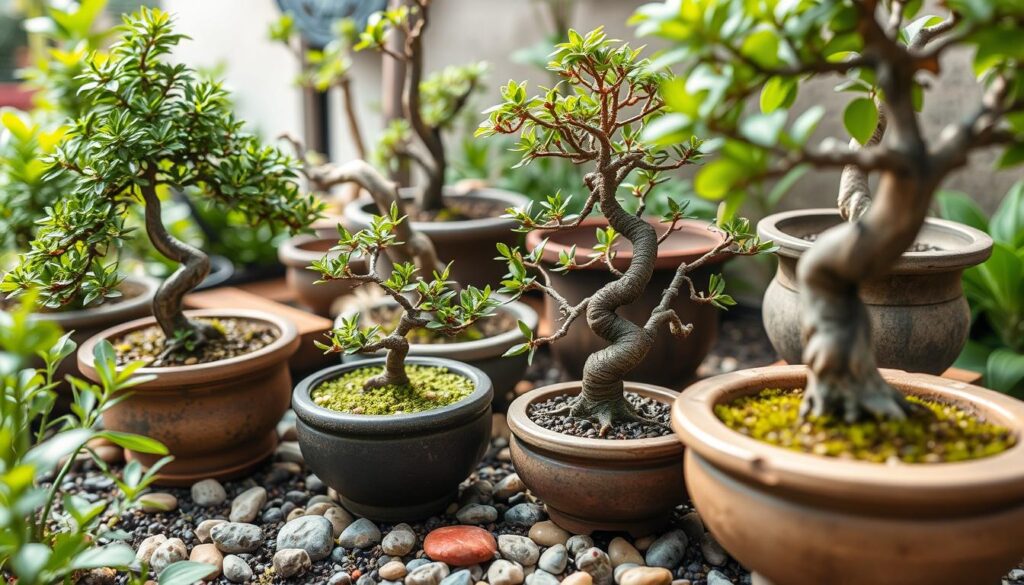
Following these guidelines helps gardeners show off their bonsai trees’ beauty. It also helps the trees grow well. The right size and shape make the bonsai display look elegant and balanced.
The Masculine and Feminine Aspects of Bonsai Pottery
In the world of bonsai, picking the right pot is more than practical. It’s an art that shows the tree’s true nature. People often see trees as either masculine or feminine. This guides their choice of bonsai pottery and container design.
Identifying Tree Characteristics
Feminine bonsai trees have smooth bark and sparse branches. They look delicate and elegant. On the other hand, masculine trees are strong with thick trunks and dense foliage. They show power and resilience.
Matching Pot Design to Tree Gender
Pot designs should match the tree’s gender. Masculine pots are deep and angular, with sturdy feet. They match the tree’s strength. Feminine pots have soft curves and delicate feet, showing the plant’s grace.
“The gender disparity in bonsai artists and hobbyists has been highlighted in reports by organizations such as the Rocky Mountain Bonsai Society.”
While many match pots to tree gender, some are moving towards inclusivity. They focus on each tree’s unique qualities and the designer’s creativity. This shift celebrates diversity in the American bonsai community.
Whether following traditional gender roles or embracing diversity, bonsai design is key. It helps highlight the tree’s qualities and creates beautiful mini landscapes.
Design Elements of Traditional Bonsai Containers
Bonsai pots vary in quality, shape, color, size, and structure. Traditional containers have specific design elements to match the tree. These include the pot’s shape, rim style, feet design, and size. The goal is to balance the tree’s look with the pot’s design.
A strong bonsai tree might go with a pot that has clean lines and a sturdy lip. A delicate tree might look better in a pot with soft curves and detailed features. The pot should show off the tree’s personality and make it look even more beautiful. It’s also important to think about frost resistance, drainage, and stability when picking a pot.
The bond between the tree and its pot is key in bonsai care. Choosing the right bonsai containers can greatly affect the tree’s health and look. Knowing about traditional bonsai pot designs helps create stunning mini gardens. These gardens show off the beauty and balance of these amazing plants.
| Design Element | Considerations |
|---|---|
| Shape | Round, oval, rectangular, etc. |
| Rim Style | Lipped or straight |
| Feet Design | Varied designs to complement the tree |
| Proportions | Balanced and harmonious with the tree |
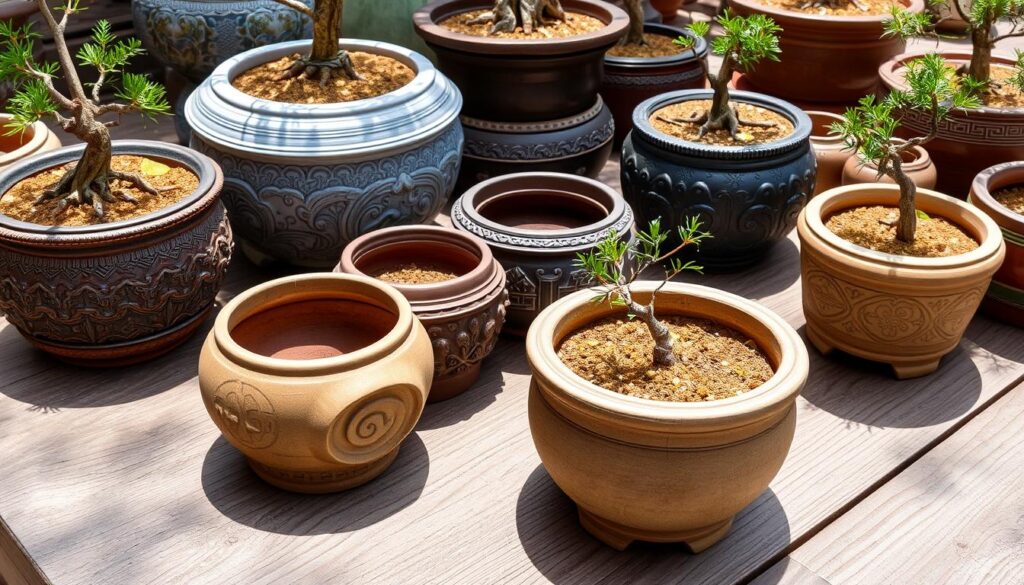
“The selection of the right bonsai pot is crucial for a well-balanced appearance, where the pot and tree should complement each other harmoniously to create an overall aesthetic appeal.”
By understanding the design elements of traditional bonsai containers and bonsai ceramics, enthusiasts can create visually stunning miniature gardens. These gardens showcase the beauty and harmonious balance of these captivating plants.
Color Selection and Glazing Techniques
Color selection and glazing techniques are key in bonsai pottery. They make your miniature garden look amazing. Choose a color that matches your bonsai tree’s natural colors, like bark, leaves, flowers, or fruits.
Understanding Glaze Types
Many bonsai fans prefer unglazed brown, gray, or earthy tones. These colors let the tree be the main focus. But, cool blues or greens can also create a striking contrast. For trees that change with the seasons, neutral or multi-colored glazes are great all year.
Seasonal Color Considerations
Think about the seasons when picking a pot color. In spring and summer, a bonsai tree looks best with a muted or earthy pot. This lets the tree’s beauty stand out. In autumn, a pot with colors that match the leaves can make the display even more stunning.
| Bonsai Tree Type | Recommended Pot Color |
|---|---|
| Conifers | Unglazed brown, gray, or earth tones |
| Deciduous Trees | Glazed pots with contrasting colors or multi-colored glazes |
| Flowering Varieties | Glazed pots with complementary colors to the blooms |
The texture of the bonsai pot is also important. Rougher pots go well with trees that have rugged bark. Smoother pots are better for trees with finer bark.
“The beauty of a bonsai tree lies in the delicate balance between the tree and its container. The right bonsai pottery can elevate the entire composition, creating a harmonious and visually stunning display.”
Choosing colors and glazing techniques for bonsai pots is an art. It needs understanding of the tree and the look you want. By thinking about these things, you can make a beautiful bonsai pottery display that shows off your miniature trees.
Special Considerations for Forest Plantings
When choosing bonsai planters for forest plantings, consider a few things. Oval-shaped pots are best because they give lots of room for multiple miniature tree pots. This keeps the look balanced and beautiful.
The size of the pot matters a lot. It should be big enough for all the trees but not too big. The pot’s color and style should also match the trees, focusing on their beauty.
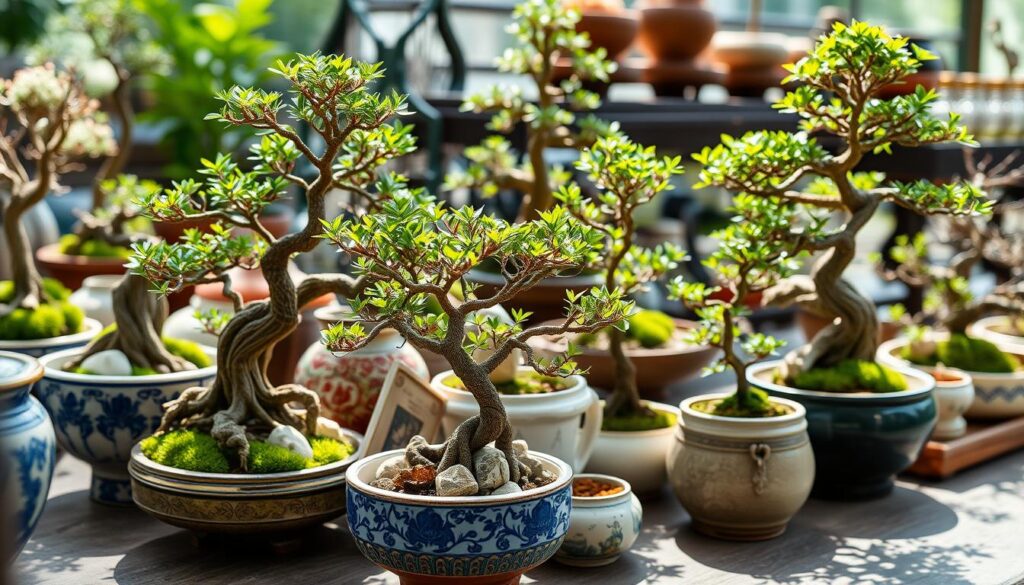
Choosing the right pot is key for a bonsai forest’s health and growth. The right shape, size, and design make a stunning miniature landscape. It brings nature’s beauty into your home.
“The container is as much a part of the bonsai as the tree itself. It must be chosen with great care to enhance the overall aesthetic.”
Think about the trees’ care needs too. Soil, water, and sunlight needs can differ. This means you need to care for each tree in a way that keeps the whole forest healthy and balanced.
By picking the best bonsai planters and meeting the trees’ needs, you can make a beautiful indoor garden. It shows off the art of bonsai in a lasting way.
Essential Features of Quality Bonsai Pots
Choosing the right pot is key for your bonsai tree’s health and look. Quality bonsai pots have features that meet your tree’s needs.
Drainage Systems
Drainage is vital for your bonsai tree. Good bonsai pots have many holes to stop waterlogging. This keeps the soil moist and prevents root rot.
Wiring Holes and Security
Bonsai trees need to be anchored, especially when young or in windy spots. Quality bonsai pots have holes for wiring. This keeps the tree stable and safe from damage.
The bonsai pot material matters too. It should be strong for outdoor use. Ceramic, porcelain, and concrete are good choices for their durability.
| Material | Advantages |
|---|---|
| Ceramic | Classic appeal, excellent moisture retention |
| Plastic | Lightweight, durable, and budget-friendly |
| Mica | Durable, natural look similar to clay pots |
| Concrete | Sturdy and suitable for large bonsai trees |
Choosing bonsai pots with these features helps your tree stay healthy and beautiful. It also makes your bonsai garden look great.
Creating Miniature Gardens Around Bonsai Trees
Miniature gardens around bonsai trees make them even more beautiful. By adding elements like stepping stones and small tables, you can turn a simple tree into a magical landscape. You can also use plants that match the bonsai to make it even more special.
Growing a bonsai tree in a garden needs the right soil, light, water, and pruning. Raised beds help with visibility and care. But, keeping the bonsai small in a regular garden can be hard.
To make a beautiful miniature garden, think about these things:
- Stepping stones to guide the eye and add depth to the display
- Miniature accessories like small tables, fences, or ornaments to complement the bonsai
- Complementary plants, such as ground covers or small succulents, to enhance the overall aesthetic
With the right design, your bonsai can become a peaceful centerpiece. Your miniature garden will be a lovely place for both the bonsai and those who see it.
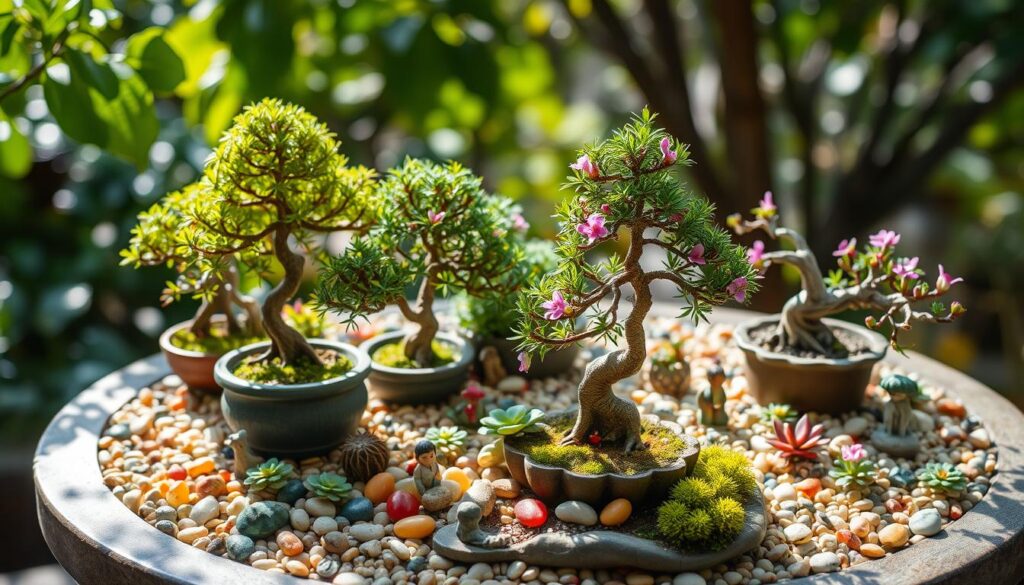
“The true essence of bonsai is found in the harmonious relationship between the tree, the container, and the surrounding environment.”
Where to Source Authentic Bonsai Containers
Finding real, top-notch bonsai containers is key for your mini garden. Luckily, many places offer authentic bonsai pottery.
Start by visiting bonsai nurseries locally. These shops have a wide range of pots, from classic Japanese to modern designs. Also, don’t miss bonsai fairs and events to meet potters and find special pots.
For online shopping, try auction sites and social media groups for bonsai fans. You’ll find lots of bonsai containers from artists and collectors.
If you dream of a custom pot, contact a potter directly. Many artists do custom work. Share your tree’s size and a photo to get the perfect fit.
“The patina on bonsai pottery can develop over very long periods with use, creating a unique and visually striking appearance.”
When looking for bonsai containers, focus on quality and authenticity. With some effort, you’ll find the ideal pot for your bonsai.
Maintenance and Care for Bonsai Pottery
It’s important to take good care of your bonsai ceramics and gardening supplies. Regular cleaning helps remove salt and algae from your pots. Make sure to avoid harsh chemicals that can harm the glaze or the pot itself.
Check your pots often for cracks or damage, especially if they’re outside in winter. Storing unused pots in a dry, safe place can help them last longer and stay in better condition.
- Remove salt deposits and algae growth through regular cleaning.
- Avoid using harsh chemicals that could damage the pot’s surface.
- Inspect pots for cracks or damage, especially after harsh weather conditions.
- Store unused pots in a dry, protected area to prevent damage.
By following these simple steps, you can keep your bonsai ceramics and bonsai gardening supplies in great shape. This will make your bonsai collection look even better and last longer.
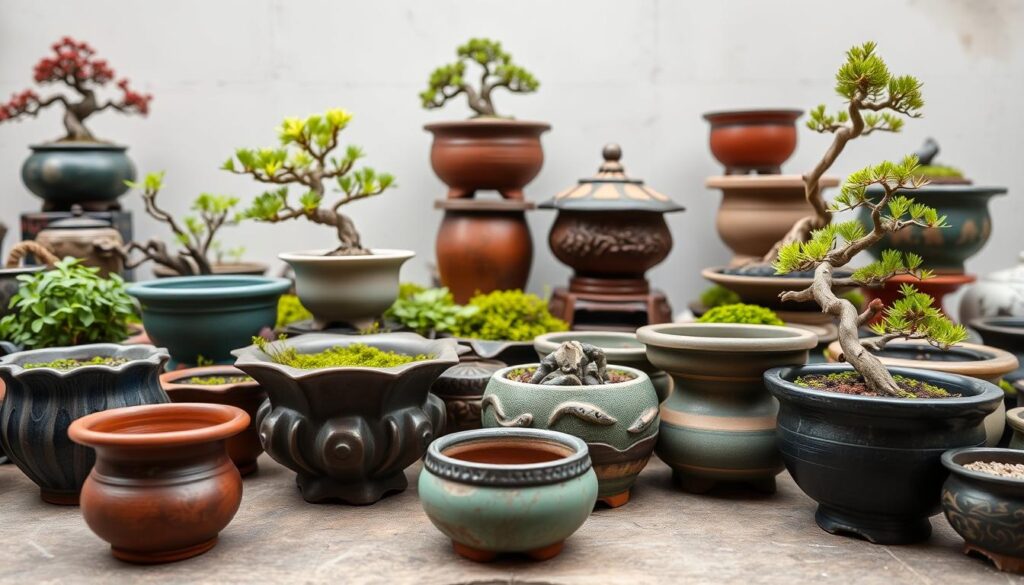
“Proper care and maintenance of bonsai pots is essential for the long-term health and beauty of your miniature garden.”
Custom Bonsai Pot Designs and Specifications
For bonsai lovers, custom pots add a special touch. They can match a tree perfectly. By teaming up with skilled pottery artists, you can choose from many bonsai pottery styles. This includes traditional Japanese designs and modern ones.
Working with Pottery Artists
Working with bonsai ceramics artists like Jack Hoover and Roy Minarai is exciting. They help you design a pot that fits your tree and looks great. They know a lot about bonsai care, making sure the pot is both functional and beautiful.
Design Consultation Process
Talking with the artist is key in the design process. You share photos of your tree and discuss its look. Then, you review sketches to make sure the pot will be perfect for your bonsai.
